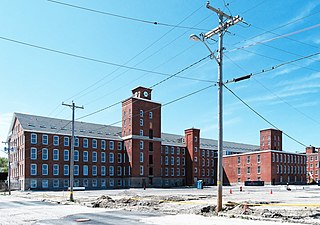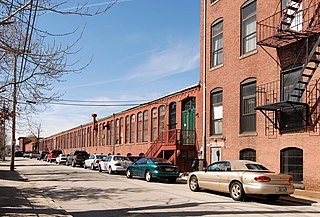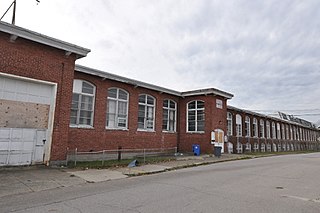
Samuel Slater was an early English-American industrialist known as the "Father of the American Industrial Revolution", a phrase coined by Andrew Jackson, and the "Father of the American Factory System". In the United Kingdom, he was called "Slater the Traitor" and "Sam the Slate" because he brought British textile technology to the United States, modifying it for American use. He stole the textile factory machinery designs as an apprentice to a pioneer in the British industry before migrating to the U.S. at the age of 21.

Wamsutta Mills is a former textile manufacturing company and current brand for bedding and other household products. Founded by Thomas Bennett, Jr. on the banks of the Acushnet River in New Bedford, Massachusetts in 1846 and opened in 1848, Wamsutta Mills was named after Wamsutta, the son of a Native American chief who negotiated an early alliance with the English settlers of the Plymouth Colony. It was the first of many textile mills in New Bedford, and gradually led to cotton textile manufacturing overtaking whaling as the town's principal industry by the 1870s.

The Slater Mill is a historic water-powered textile mill complex on the banks of the Blackstone River in Pawtucket, Rhode Island, modeled after cotton spinning mills first established in England. It is the first water-powered cotton spinning mill in America to utilize the Arkwright system of cotton spinning as developed by Richard Arkwright.

The Boston Manufacturing Company was a business that operated one of the first factories in America. It was organized in 1813 by Francis Cabot Lowell, a wealthy Boston merchant, in partnership with a group of investors later known as The Boston Associates, for the manufacture of cotton textiles. It built the first integrated spinning and weaving factory in the world at Waltham, Massachusetts, using water power. They used plans for a power loom that he smuggled out of England as well as trade secrets from the earlier horse-powered Beverly Cotton Manufactory, of Beverly, Massachusetts, of 1788. This was the largest factory in the U.S., with a workforce of about 300. It was a very efficient, highly profitable mill that, with the aid of the Tariff of 1816, competed effectively with British textiles at a time when many smaller operations were being forced out of business. While the Rhode Island System that followed was famously employed by Samuel Slater, the Boston Associates improved upon it with the "Waltham System". The idea was successfully copied at Lowell, Massachusetts, and elsewhere in New England. Many rural towns now had their own textile mills.

Henry Frederick Lippitt was a member of the prominent Lippitt family, which made its fortune in the textile business, and served as United States Senator from Rhode Island.

Oliver Chace was an American 18th and 19th-century businessman. He was the founder of several New England textile manufacturing companies in the early 19th century, including the Valley Falls Company, the original antecedent of Berkshire Hathaway, which as of 2019 is one of the largest and most valuable companies in the world.

Ironstone is an historic village,, in the township of Uxbridge, Massachusetts, United States. It derived its name from plentiful bog iron found here which helped Uxbridge to become a center for three iron forges in the town's earliest settlement. South Uxbridge has historic sites, picturesque weddings, hospitality, industrial and distribution centers, and the new Uxbridge High School. This community borders North Smithfield, and Burrillville, Rhode Island, and Millville, Massachusetts. South Uxbridge receives municipal services from Uxbridge, for fire, police, EMS, School district, public works, and other services. There is a South Uxbridge fire station of the Uxbridge fire department. Worcester's Judicial District includes Uxbridge District Court. Ironstone appears on the Blackstone U.S. Geological Survey Map. Worcester County is in the Eastern time zone and observes DST.

The Oriental Mills are a historic textile mill complex at 10 Admiral Street in Providence, Rhode Island. The site consists of seven buildings, constructed between about 1860 and 1917, by a variety of textile manufacturers that operated on the site. The oldest building, from c. 1860, was built by the Oriental Mills Manufacturing Company soon after its founding. It is a large three-story brick structure, presenting eight bays to Admiral Street and thirty to Whipple Street. It has a well-defined Italianate roof line with brackets. Building 3, which lies southeast of Building 1 and fronts on Oriental Street, is from the same time period and exhibits similar styling. Originally used for the manufacture of cotton textiles, the complex was purchased in 1918 by the American Silk Spinning Company, which pioneered the blending of nylon fibers into its products here.

The Hope Village Historic District is a historic rural mill settlement within Hope Village in Scituate, Rhode Island. Hope Village is located on a bend in the North Pawtuxet River in the southeastern corner of Scituate. Industrial activity has occurred in Hope Village since the mid-eighteenth century. Surviving industrial and residential buildings in the Historic District date back to the early 19th century. The village center sits at junction of Main Street and North Road. Hope Village radiates out from the center with houses on several smaller side streets in a compact configuration. Currently there is little commercial or industrial activity in Hope Village and none in the Historic District. The present stone mill building on the south side of Hope Village was built in 1844 by Brown & Ives of Providence, expanded in 1871 and modified in 1910. Approximately one quarter of the village's current housing stock was built as mill worker housing by various owners of Hope Mill.

The Valley Queen Mill is an historic mill at 200 Providence Street in West Warwick, Rhode Island.

The Church Hill Industrial District is an industrial historic district on the west side of Pawtucket, Rhode Island. It encompasses an area that was intensively developed between about 1850 and 1920, and includes five separate industrial facilities. Four of these are relatively modest in size, and originally served a combination of textile mills and ironworks, the latter of which often manufactured parts used in the textile manufacturing processes. The oldest building is an 1848 ironworks facility, which runs along Pine Street between Main and Bayley. The largest single complex, added in the 2011 expansion of the district, is the Union Waddell complex between Bayley Street and the Amtrak railroad tracks, which has ten surviving buildings from the early 20th century.

The Conant Thread—Coats & Clark Mill Complex District is a historic district encompassing a large industrial complex which straddles the border between Pawtucket and Central Falls, Rhode Island. This 50-acre (20 ha) industrial area was developed in two phases, with a number of buildings surviving from both of these periods. The first, between 1870 and 1882, resulted in the construction of Mills 2 through 5, a series of large three- and four-story brick buildings which were used in textile manufacturing. A brick office and stables from this period were demolished in 1977, and are the only known brick structures to have been lost. The second phase of construction was between 1917 and 1923, and included the construction of two additional four-story brick mills, a stuccoed recreation hall that has since been converted into a senior center, two two-story brick buildings, and a power plant. This works was first developed by J & P Coats, and became an internationally known source for cotton thread. It was for many years Pawtucket's largest employer.

The Hope Webbing Company Mill is a historic textile mill at 999-1005 Main Street in Pawtucket, Rhode Island. The three brick buildings on this 7-acre (2.8 ha) are the surviving elements of what was once a larger complex, extending across Esten Avenue. The oldest portion of the main mill and the boiler house were built in 1889, with the mill growing by numerous additions through 1914. The preparing building was built in 1902 and enlarged in 1913. The Hope Webbing Company was established in 1883, and used these premises to manufacture narrow fabrics using many different types of fibers, including cotton, jute, wool, and silk. The company occupied all or part of the premises until 1994, when it moved its remaining production to Cumberland.

The Valley Falls Company was founded in 1839 by Oliver Chace, in Valley Falls, Rhode Island, a historic mill village on both sides of the Blackstone River, within the modern-day town of Cumberland and city of Central Falls, Rhode Island. The Valley Falls Company is the original antecedent of Berkshire Hathaway, currently one of the world's largest and most successful companies.
The city of Woonsocket in the U.S. state of Rhode Island was established as a union of six mill villages along the Blackstone River. These villages are described in more detail below.

Blackstone River Valley National Historical Park is a National Park Service unit in the states of Rhode Island and Massachusetts. The park was created for the purpose of preserving, protecting, and interpreting the industrial heritage of the Blackstone River Valley and the urban, rural, and agricultural landscape of that region. The Blackstone River Valley was the site of some of the earliest successful textile mills in the United States, and these mills contributed significantly to the earliest American Industrial Revolution. The subsequent construction of the Blackstone Canal, a few years after the successful completion of the Erie Canal, helped to sustain the region's industrial strength.

C. R. Makepeace & Company, established in 1889, was a nationally active firm of mill architects based in Providence, Rhode Island. It was dissolved in 1944.

The Naushon Company Plant is a historic textile mill complex at 32 Meeting Street in Cumberland, Rhode Island. First built in 1902-04 and enlarged over time, it illustrates the adaption of the site to differing uses between then and the 1950s, when its use for textile manufacture ended. The complex was listed on the National Register of Historic Places in 1978.
Joseph Jenckes Jr., also spelled Jencks and Jenks, was the founder of Pawtucket, Rhode Island, where he erected a forge in 1671.
The Moore Fabric Company Plant is a historic industrial complex at 45-47 Washington Street in Pawtucket, Rhode Island. The complex consists of five buildings built between 1878 and 1954, primarily for the purpose of manufacturing textiles with elastic components, although the oldest structure was built as a school. The complex was listed on the National Register of Historic Places in 2019. Plans have been laid to convert the property to residential use.




















